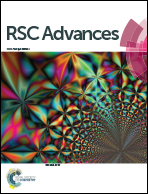Monodisperse polylactide microcapsules with a single aqueous core prepared via spontaneous emulsification and solvent diffusion†
Abstract
A simple approach to preparing monodisperse poly(D,L-lactide) (PDLLA) microcapsules with a single aqueous core is developed. The method is based on automatic water-in-oil-in-water double emulsion formation from oil-in-water single emulsion via spontaneous emulsification which voluntarily disperses part of continuous aqueous phase into the dispersed oil phase dissolving oil-soluble amphiphilic diblock copolymer, poly(D,L-lactide)-b-poly(2-dimethylaminoethyl methacylate)(PDLLA-b-PDMAEMA), followed by coalescence of tiny water droplets within the polymer droplets, coupled with quick precipitation of polymers by diluting the emulsion with water. In this study, we have investigated the effect of PDLLA to PDLLA-b-PDMAEMA ratios and flow rates of each solution during preparing the emulsion on the final morphology and the size of the microcapsules. It was found that the polymer blend ratio played a crucial role in determining internal structure of the microcapsules. The microcapsules size decreased with the increment of the flow rate ratios of the continuous phase to the dispersed phase and eventually reached 10 μm, while maintaining narrow size distribution. In addition, we have demonstrated that the microcapsules can encapsulate both hydrophilic and hydrophobic compounds during the formation.


 Please wait while we load your content...
Please wait while we load your content...